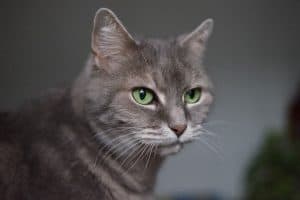Cats have long been associated with femininity, from their graceful movements to their expressive eyes. Many cat owners have noticed this phenomenon, prompting the question: why do cats look feminine? Let’s explore this intriguing topic further.
With their lithe bodies, delicate features, and elegant mannerisms, cats exude a sense of grace and beauty that is often associated with femininity. This inherent charm has captured the hearts of humans for centuries, leading to the perception of cats as symbols of femininity.
The Role of Physical Characteristics
Cats have a distinct feminine charm due to their unique physical traits. Their slender bodies and graceful movements often evoke a sense of elegance, similar to how we perceive femininity in humans. The soft fur of cats adds to this delicate aura, inviting us to caress and cuddle them like we would a precious doll. Additionally, their expressive eyes, often large and emotive, capture our attention and convey a sense of depth and mystery, traits commonly associated with femininity.
The Influence of Cultural Perceptions
Throughout history, cats have been intertwined with notions of femininity in various cultures. In ancient Egypt, the goddess Bastet was depicted as a cat-headed woman, symbolizing maternal warmth and protection. Fast forward to modern times, where popular media often portrays cats as graceful and elegant, reinforcing the association with femininity. These cultural depictions shape our perception of cats and contribute to why they are often seen as inherently feminine creatures.
Extra insight: Furthermore, the purring of cats, often associated with comfort and contentment, can also be linked to the nurturing and soothing qualities typically associated with femininity. This gentle sound reinforces the idea of cats embodying feminine traits, adding another layer to their overall charm and appeal.
The Psychology Behind the Perception
Cats are often perceived as feminine due to their graceful movements, sleek appearance, and mysterious nature. Humans tend to associate these traits with traditional concepts of beauty and elegance, commonly attributed to femininity. The way cats effortlessly navigate their surroundings and display a sense of intuition can evoke feelings of grace and poise in observers, reinforcing the perception of femininity.
Another factor contributing to this perception is the way cats groom themselves meticulously, paying close attention to their appearance and cleanliness. This meticulous grooming behavior can be seen as a feminine trait, as it aligns with societal expectations of women taking care of their physical appearance.
Evolutionary Explanations
Evolutionary theories suggest that cats have evolved to exhibit traits commonly associated with femininity as a survival mechanism. For example, their ability to hunt with precision and agility can be linked to the nurturing instincts traditionally associated with motherhood. Female cats in the wild are responsible for protecting and providing for their offspring, showcasing traits like patience, resourcefulness, and adaptability.
Additionally, the sleek and slender physique of cats may have evolved to enhance their hunting abilities, allowing them to move swiftly and silently to catch prey. This physical prowess, combined with their keen senses and calculated movements, can be perceived as feminine due to the grace and elegance with which they navigate their environment.
In conclusion, the perception of cats as feminine is a complex interplay of psychological associations with beauty and elegance, as well as evolutionary adaptations that have shaped their behavior and physical characteristics. By understanding these factors, we can appreciate the unique allure of feline grace and charm. Feel free to explore further through this external link on the evolution of feline traits.
Interesting Facts About Cats
Cats have an air of mystique and elegance that many find captivating. But have you ever wondered why they often appear so feminine? While not exclusive to female cats, their sleek bodies, graceful movements, and delicate features can give off a distinctly feminine vibe. It’s a combination of factors that contribute to this perception.
One interesting fact to note is that male cats can also exhibit feminine traits in their appearance and behavior. This can be attributed to the influence of domestication, which has shaped cats over centuries. By understanding this process, we can gain insight into why cats often exude a sense of femininity.
The Influence of Domestication
Domestication has played a significant role in shaping cats’ physical characteristics and behaviors. Through selective breeding and evolution, humans have unintentionally influenced the appearance of cats to align with certain aesthetics. As a result, cats may exhibit features traditionally associated with femininity, such as slender bodies, refined facial features, and graceful movements.
Additionally, the domestication process has also impacted cats’ behaviors, further contributing to their perceived femininity. Cats are known for their nurturing and affectionate nature, traits often associated with femininity. This gentle demeanor, along with their elegant appearance, can create a sense of femininity in both male and female cats.
Overall, the influence of domestication has subtly shaped the way we perceive cats, leading to the widespread association of feline traits with femininity. It’s a fascinating interplay of genetics, evolution, and human intervention that continues to shape our understanding and appreciation of these enigmatic creatures. If you’re interested in learning more about the impact of domestication on cats, check out this informative resource from the Smithsonian’s National Zoo: Domestication and Cat Breeds.
The Bond Between Cats and Humans
Cats have long been associated with femininity, thanks in part to the unique bond they share with humans. Unlike dogs, who often display overt loyalty and obedience, cats tend to maintain an air of independence and mystery. This enigmatic quality can be perceived as more subtle and delicate, characteristics often associated with femininity. Additionally, the nurturing and caretaking roles traditionally assigned to women may also play a role in reinforcing the idea of cats as feminine creatures.
Moreover, the emotional connection that many humans feel towards their feline companions further blurs the lines between human and animal characteristics. Cats are known for their ability to comfort and provide companionship, traits that are often associated with feminine qualities such as empathy and sensitivity. This deep emotional bond can influence how we perceive and interact with cats, leading us to see them through a lens of femininity.
In addition to these factors, the historical association of cats with goddesses in ancient cultures further cements the connection between femininity and felines. Cats were often worshipped as symbols of fertility, grace, and independence, traits typically associated with femininity. This long-standing cultural influence has contributed to the prevailing perception of cats as inherently feminine creatures.
Overall, the unique bond between cats and humans, characterized by their enigmatic nature, emotional connection, and historical symbolism, has played a significant role in shaping the perception of cats as feminine beings.
Unique Insight: Cats’ grooming behavior, often seen as a feminine trait due to its meticulous and fastidious nature, further reinforces the perception of cats as feminine creatures. This grooming ritual, where cats clean themselves with delicate precision, adds to their overall elegant and refined demeanor, contributing to their association with femininity.
Alex, a passionate animal lover, has experience in training and understanding animal behavior. As a proud pet parent to two dogs and three cats, he founded AnimalReport.net to share insights from animal experts and expand his knowledge of the animal kingdom.









